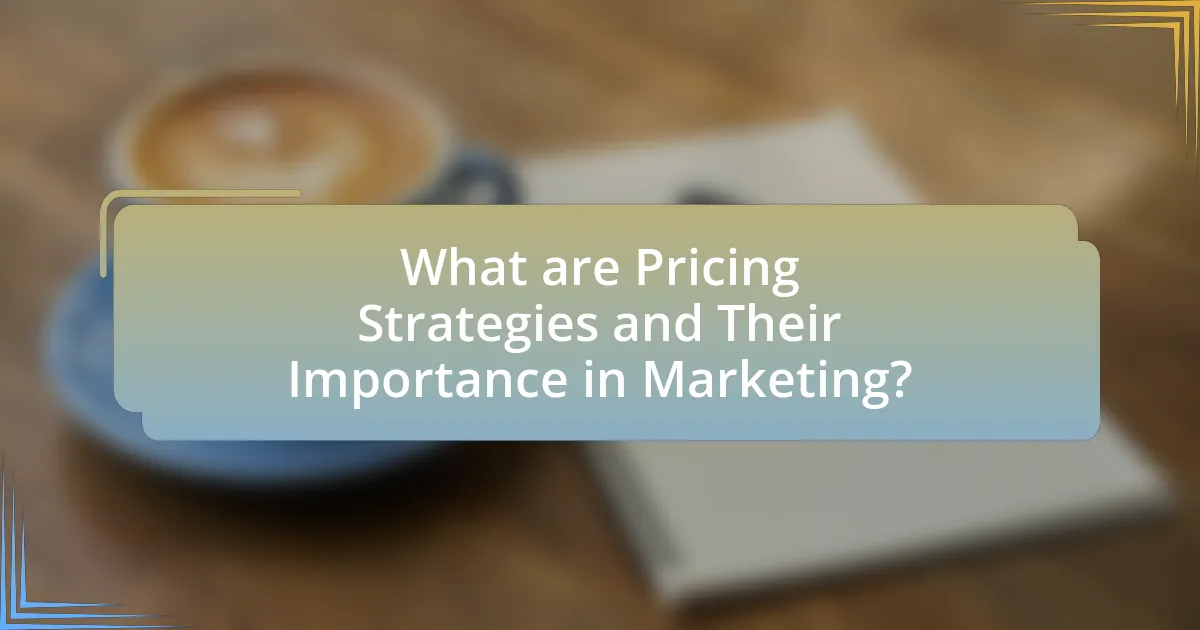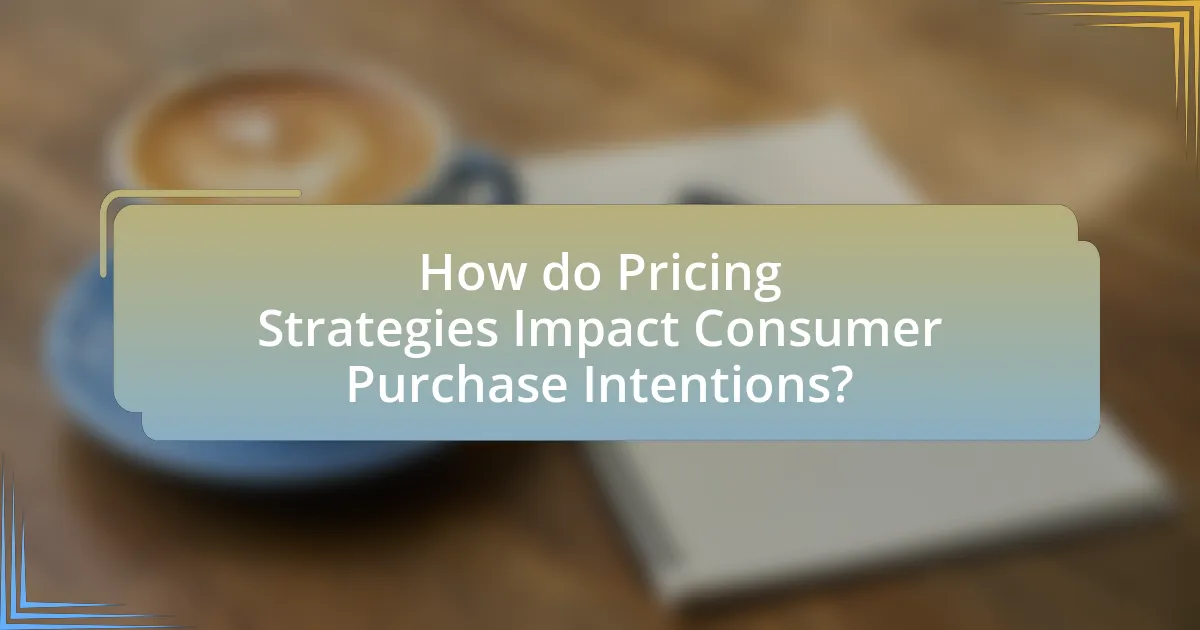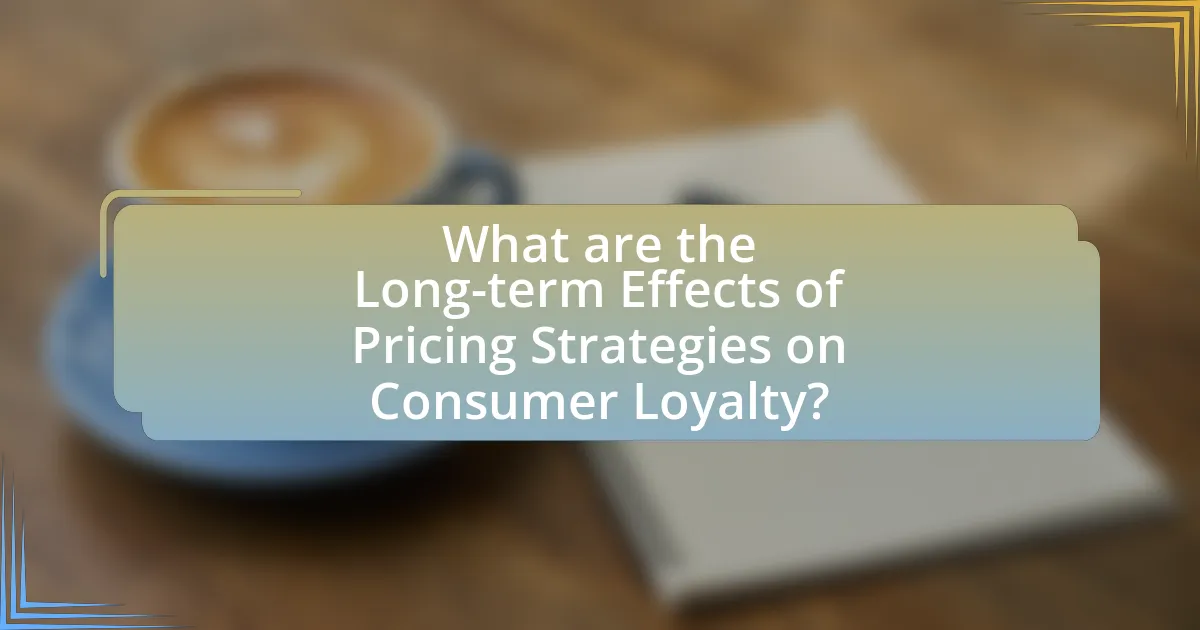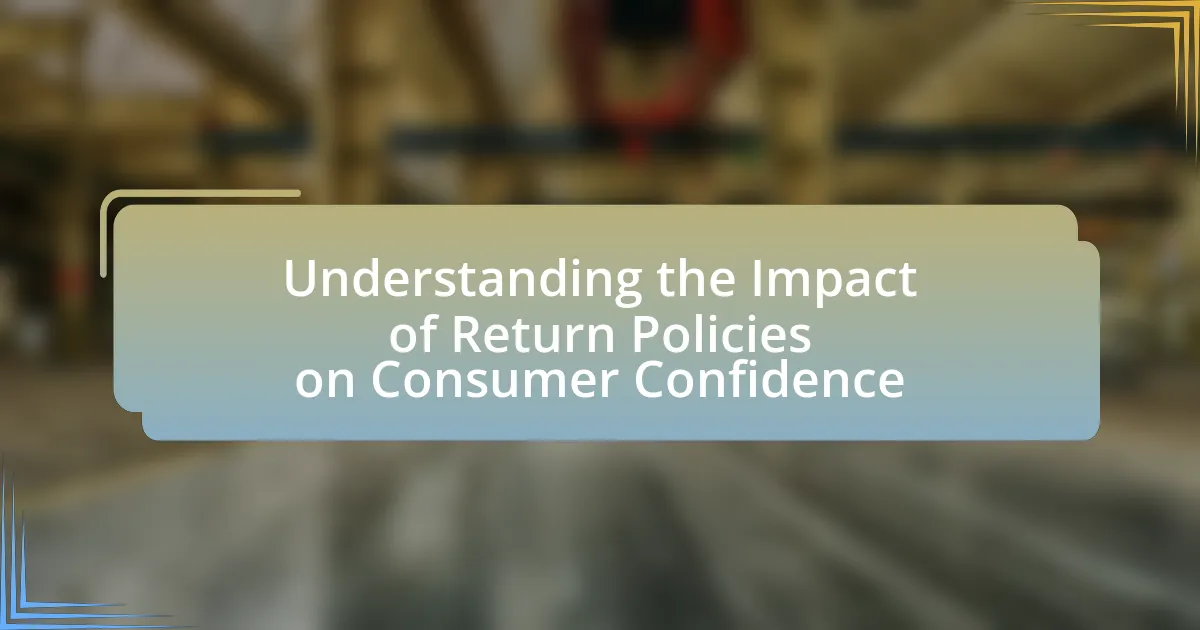The article examines the influence of pricing strategies on consumer purchase intentions, highlighting the significance of various methods such as cost-plus, value-based, and psychological pricing. It discusses how these strategies affect consumer perceptions of value, urgency, and overall purchasing behavior, emphasizing the importance of aligning pricing with consumer expectations. Additionally, the article explores the long-term effects of consistent pricing on brand loyalty and trust, as well as best practices for businesses to optimize their pricing strategies through data analysis and customer feedback.

What are Pricing Strategies and Their Importance in Marketing?
Pricing strategies are methods used by businesses to set the prices of their products or services, which significantly influence consumer purchase intentions. These strategies, such as cost-plus pricing, value-based pricing, and competitive pricing, help businesses position their offerings in the market effectively. For instance, a study by Nagle and Holden (2002) highlights that effective pricing strategies can lead to increased sales and market share by aligning prices with consumer perceptions of value. Additionally, research indicates that consumers often associate higher prices with higher quality, which can enhance brand perception and drive purchase decisions. Thus, the importance of pricing strategies in marketing lies in their ability to directly affect consumer behavior and overall business success.
How do different pricing strategies influence consumer behavior?
Different pricing strategies significantly influence consumer behavior by affecting perceptions of value and purchase intentions. For instance, psychological pricing, such as setting a price at $9.99 instead of $10, can create a perception of a better deal, leading to increased sales. Research by Thomas and Morwitz (2005) in the Journal of Consumer Research indicates that consumers are more likely to purchase items priced just below a round number due to cognitive biases. Additionally, promotional pricing, such as discounts or limited-time offers, can create urgency and encourage impulse buying, as demonstrated by studies showing that time-limited promotions increase consumer urgency and purchase likelihood. Overall, the choice of pricing strategy directly impacts how consumers perceive products and their willingness to buy.
What are the key types of pricing strategies used in marketing?
The key types of pricing strategies used in marketing include cost-plus pricing, value-based pricing, penetration pricing, skimming pricing, and competitive pricing. Cost-plus pricing involves adding a markup to the cost of goods sold, ensuring that all costs are covered while generating profit. Value-based pricing sets prices based on the perceived value to the customer rather than the actual cost, often leading to higher margins. Penetration pricing aims to attract customers by setting a low initial price to gain market share quickly, while skimming pricing involves setting high prices initially and lowering them over time to maximize profits from different customer segments. Competitive pricing focuses on setting prices based on competitors’ strategies, prices, and market conditions to remain competitive. These strategies influence consumer purchase intentions by aligning pricing with perceived value and market dynamics.
How do psychological pricing tactics affect consumer perceptions?
Psychological pricing tactics significantly influence consumer perceptions by creating a perception of value and affordability. For instance, pricing items at $9.99 instead of $10.00 can lead consumers to perceive the product as being significantly cheaper, even though the difference is minimal. Research conducted by Thomas and Morwitz (2009) in the Journal of Consumer Research demonstrates that consumers are more likely to purchase products priced just below a round number due to the cognitive bias known as the left-digit effect, where the first digit of a price disproportionately impacts consumer judgment. This tactic effectively enhances the attractiveness of products, thereby increasing the likelihood of purchase.
Why is understanding consumer purchase intentions crucial for businesses?
Understanding consumer purchase intentions is crucial for businesses because it directly influences sales strategies and revenue generation. By analyzing these intentions, businesses can tailor their pricing strategies to align with consumer expectations and preferences, ultimately enhancing customer satisfaction and loyalty. Research indicates that 70% of consumers are influenced by pricing when making purchase decisions, highlighting the importance of understanding these intentions to optimize pricing models effectively.
What factors contribute to consumer purchase intentions?
Consumer purchase intentions are influenced by several key factors, including pricing strategies, perceived value, brand reputation, and social influences. Pricing strategies, such as discounts and promotions, directly affect consumers’ perceptions of value, leading to increased purchase intentions. Research indicates that consumers are more likely to buy products when they perceive a favorable price-to-value ratio, as shown in studies by Monroe (2003) in the Journal of Retailing, which highlights the importance of perceived value in driving purchase decisions. Additionally, brand reputation plays a crucial role; consumers tend to trust well-established brands, which can enhance their willingness to purchase. Social influences, such as recommendations from friends or online reviews, also significantly impact purchase intentions, as demonstrated in a study by Chevalier and Mayzlin (2006) in the Journal of Marketing Research, which found that positive reviews can lead to increased sales.
How do pricing strategies align with consumer expectations and needs?
Pricing strategies align with consumer expectations and needs by reflecting perceived value and affordability. When businesses set prices based on market research, they can match consumer willingness to pay, ensuring that products are seen as valuable yet accessible. For instance, a study by Nagle and Holden (2002) highlights that consumers often associate higher prices with higher quality, influencing their purchasing decisions. Additionally, promotional pricing tactics, such as discounts or bundling, cater to consumer desires for savings and perceived value, further aligning pricing with expectations. This alignment fosters trust and satisfaction, ultimately enhancing purchase intentions.

How do Pricing Strategies Impact Consumer Purchase Intentions?
Pricing strategies significantly influence consumer purchase intentions by affecting perceived value and affordability. For instance, psychological pricing, such as setting a price at $9.99 instead of $10, can create a perception of a better deal, thereby increasing the likelihood of purchase. Research by Thomas and Morwitz (2005) in the Journal of Consumer Research indicates that consumers are more likely to buy products when they perceive prices as lower due to such strategies. Additionally, promotional pricing, like discounts or limited-time offers, can create urgency, prompting quicker purchasing decisions. A study by Gedenk and Van Herpen (2009) found that consumers are more inclined to purchase when they perceive a temporary price reduction, demonstrating the direct impact of pricing strategies on their intentions to buy.
What role does price perception play in consumer decision-making?
Price perception significantly influences consumer decision-making by shaping how individuals evaluate the value of a product or service. When consumers perceive a price as fair or reasonable, they are more likely to proceed with a purchase; conversely, if they view a price as too high, they may abandon the transaction. Research indicates that 70% of consumers consider price as a primary factor in their purchasing decisions, highlighting its critical role in determining purchase intentions. Additionally, psychological pricing strategies, such as charm pricing (e.g., pricing items at $9.99 instead of $10), can enhance positive price perception, further driving consumer behavior.
How does perceived value influence purchase intentions?
Perceived value significantly influences purchase intentions by shaping consumers’ assessments of a product’s worth relative to its cost. When consumers perceive high value, they are more likely to intend to purchase, as they believe the benefits outweigh the price. Research indicates that a positive perceived value can increase purchase likelihood by up to 30%, as consumers feel they are making a smart financial decision. This relationship is supported by studies showing that effective pricing strategies, such as discounts or bundling, enhance perceived value, thereby driving higher purchase intentions.
What is the relationship between price sensitivity and consumer behavior?
Price sensitivity directly influences consumer behavior by determining how changes in price affect purchasing decisions. Consumers who exhibit high price sensitivity are more likely to alter their buying habits in response to price fluctuations, often seeking lower-priced alternatives or delaying purchases when prices rise. Research indicates that approximately 70% of consumers consider price as a primary factor in their purchasing decisions, highlighting the significant role of price sensitivity in shaping market dynamics. This relationship underscores the importance of pricing strategies for businesses aiming to optimize consumer purchase intentions and maximize sales.
How do promotional pricing strategies affect consumer purchase intentions?
Promotional pricing strategies significantly enhance consumer purchase intentions by creating a sense of urgency and perceived value. When consumers encounter discounts or limited-time offers, they are more likely to perceive the product as a better deal, which can lead to increased motivation to purchase. Research indicates that promotional pricing can lead to a 20-30% increase in sales volume during promotional periods, as consumers are driven by the fear of missing out on a good deal. Additionally, studies show that consumers often associate promotional pricing with higher quality, further influencing their intention to buy.
What are the effects of discounts and sales on consumer choices?
Discounts and sales significantly influence consumer choices by increasing the perceived value of products and prompting immediate purchasing decisions. Research indicates that consumers are more likely to buy items when they perceive a discount, as it creates a sense of urgency and a fear of missing out on a good deal. For example, a study published in the Journal of Marketing Research found that limited-time offers can lead to a 20-30% increase in sales volume, as consumers are motivated by the opportunity to save money. Additionally, discounts can shift consumer preferences towards discounted items over non-discounted alternatives, further impacting overall purchasing behavior.
How do limited-time offers create urgency in purchasing decisions?
Limited-time offers create urgency in purchasing decisions by instilling a fear of missing out, prompting consumers to act quickly to secure the deal. This urgency is driven by the psychological principle of scarcity, where the perception of limited availability increases the desirability of the product. Research indicates that consumers are more likely to make impulsive purchases when faced with time constraints, as demonstrated in a study published in the Journal of Consumer Research, which found that limited-time promotions significantly boost sales by creating a sense of urgency.

What are the Long-term Effects of Pricing Strategies on Consumer Loyalty?
Long-term effects of pricing strategies on consumer loyalty include increased retention rates and enhanced brand trust. When companies implement consistent and transparent pricing strategies, such as value-based pricing or loyalty discounts, they foster a sense of fairness and reliability among consumers. Research indicates that brands employing these strategies can see loyalty rates increase by up to 20%, as consumers are more likely to return to brands that they perceive as offering fair value over time. Additionally, a study by Kumar and Shah (2004) in the Journal of Marketing found that effective pricing strategies significantly correlate with customer satisfaction, which is a key driver of loyalty. Thus, strategic pricing not only influences immediate purchase decisions but also cultivates long-term consumer loyalty.
How do consistent pricing strategies build consumer trust?
Consistent pricing strategies build consumer trust by creating predictability and transparency in transactions. When consumers encounter stable prices, they feel more secure in their purchasing decisions, as they can anticipate costs without fear of sudden increases or hidden fees. Research indicates that 70% of consumers prefer brands that maintain consistent pricing, as it fosters a sense of reliability and fairness. This trust is further reinforced when companies uphold their pricing policies over time, leading to stronger customer loyalty and repeat purchases.
What impact does price consistency have on brand loyalty?
Price consistency positively impacts brand loyalty by fostering trust and predictability among consumers. When brands maintain stable pricing, customers are more likely to perceive the brand as reliable, which enhances their emotional connection and commitment. Research indicates that 70% of consumers are more loyal to brands that offer consistent pricing, as it reduces the perceived risk associated with purchasing decisions. This consistency allows consumers to feel confident in their choices, leading to repeat purchases and long-term loyalty.
How can businesses balance pricing strategies with customer retention efforts?
Businesses can balance pricing strategies with customer retention efforts by implementing tiered pricing models that offer value at different price points while maintaining customer loyalty. This approach allows businesses to cater to various customer segments, ensuring that both price-sensitive and premium customers feel valued. For instance, a study by McKinsey & Company found that companies using tiered pricing can increase customer retention by up to 20% as they provide options that meet diverse needs. Additionally, incorporating loyalty programs that reward repeat purchases can further enhance retention, as customers are incentivized to remain engaged with the brand despite price fluctuations.
What best practices should businesses follow regarding pricing strategies?
Businesses should adopt a value-based pricing strategy, which aligns prices with the perceived value of their products or services to consumers. This approach enhances consumer purchase intentions by ensuring that customers feel they are receiving fair value for their money. Research indicates that 70% of consumers are willing to pay more for products they perceive as high quality, demonstrating the effectiveness of this strategy. Additionally, businesses should regularly analyze competitor pricing and market trends to remain competitive, as 60% of consumers compare prices before making a purchase decision. Implementing psychological pricing techniques, such as charm pricing (e.g., pricing items at $9.99 instead of $10), can also positively influence consumer behavior, as studies show that such pricing can increase sales by up to 24%.
How can businesses effectively test and adapt their pricing strategies?
Businesses can effectively test and adapt their pricing strategies by employing A/B testing, analyzing customer feedback, and utilizing data analytics. A/B testing allows businesses to compare different pricing models in real-time, measuring consumer response to each variant. For instance, a study by the Harvard Business Review found that companies using A/B testing for pricing saw a 10-20% increase in conversion rates. Analyzing customer feedback provides insights into perceived value and price sensitivity, enabling adjustments that align with consumer expectations. Additionally, leveraging data analytics helps identify trends and patterns in purchasing behavior, allowing businesses to make informed pricing decisions based on historical sales data and market conditions.
What tools and metrics can help analyze the effectiveness of pricing strategies?
To analyze the effectiveness of pricing strategies, businesses can utilize tools such as pricing analytics software, A/B testing platforms, and customer relationship management (CRM) systems. Pricing analytics software, like Pricefx or PROS, enables companies to assess price elasticity, monitor competitor pricing, and evaluate sales performance against pricing changes. A/B testing platforms, such as Optimizely, allow businesses to experiment with different pricing models and measure consumer response, providing direct insights into purchase intentions. CRM systems, like Salesforce, help track customer interactions and purchasing behavior, offering valuable data on how pricing affects consumer decisions. These tools collectively provide quantitative metrics such as conversion rates, average order value, and customer lifetime value, which are essential for evaluating the impact of pricing strategies on consumer purchase intentions.





